How to Store Strawberries: 6 Simple Methods
Updated: Apr. 22, 2024
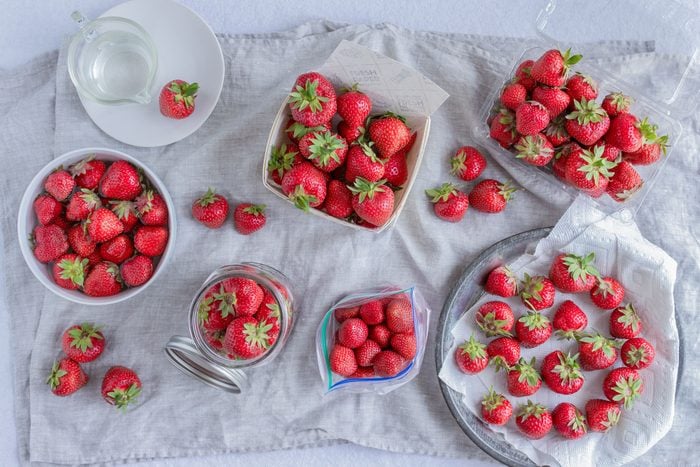
We tested six methods for how to store strawberries so you can keep your strawberries fresh for as long as possible.
Strawberries are so luscious and flavorful, especially when you pick your own or buy from a local fruit stand at the height of strawberry season. There’s a taste of summer in every berry! They’re too delicious to lose any to mushiness or mold, but keeping strawberries fresh once you get them home can be a challenge.
There are a lot of opinions out there on how to store strawberries, so we put some popular methods to the test. The longer we can keep strawberries fresh, the more sweet and savory strawberry recipes we can make! Here’s what we learned about storing strawberries, plus the method we liked most.
How We Tested These Methods
Because the fridge is the best place to keep strawberries when you need to store them for more than a day, all of the methods we tested are refrigerator options. The cold environment inhibits bacteria and mold spores to prevent the berries from spoiling.
In each case, we tested strawberries stored in the refrigerator for seven days (except for the freezer method). With each method, our goal was to have our strawberries stay as fresh and plump as the day we brought them home. The best refrigerator storage solution would prevent the berries from turning moldy or developing mushy spots, even after a week. Although not as critical, storage methods that kept the leaves green and attractive scored points as well.
Want to keep your strawberries fresh for longer? Check how to freeze strawberries so that you’ll preserve their quality, nutritional value and most importantly, flavor.
The Best Methods for Storing Strawberries
Method 1: Original container
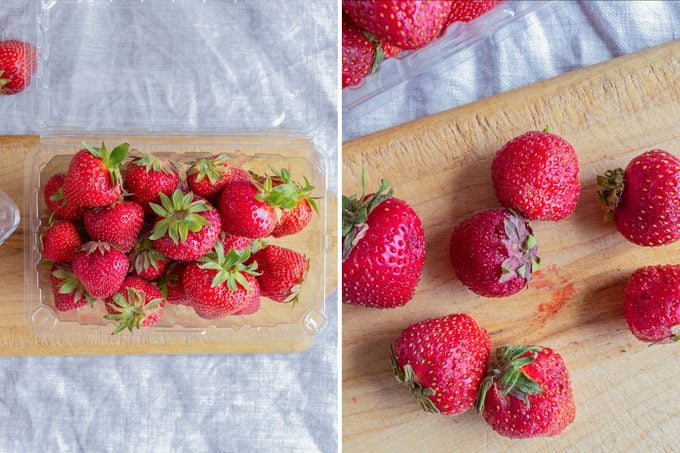
About this method: Strawberries are typically sold in plastic clamshell boxes or berry baskets made of wood or cardboard. They have openings along the sides and lid to let air flow around the berries.
How to do it: This is the easiest method to try: just pop the container in the fridge. (Though if you see moldy or mushy berries, remove those first.) This method is best for whole strawberries.
The verdict: Not bad
This method works fine to store your fresh strawberries in the fridge, but only for a few days. After seven days, they had some mushy spots and a few specks of mold growing. The leaves also looked withered. The strawberries for the most part were still edible and would be best sliced up for a recipe so that the bad spots can be cut away.
This storage method is OK if you don’t have time for anything else, as long as you can use the berries in three to four days.
Method 2: Vinegar bath
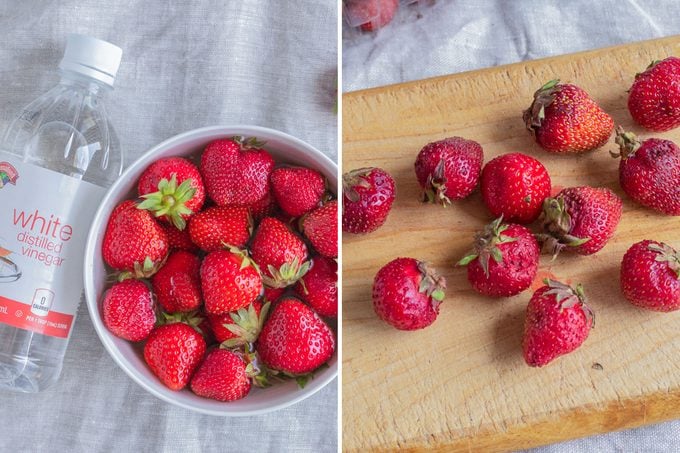
About this method: Freshly picked berries have naturally occurring mold spores on them, which is what eventually will make them spoil. Rinsing strawberries in a vinegar bath supposedly kills these spores, allowing the berries to stay fresh.
How to do it: For this method, stir one cup of white vinegar into two cups of water. Place strawberries in the mixture and gently swish them around for about a minute. Then, rinse the berries off under clean water (this mini colander is perfect for washing berries). Lay the strawberries out to dry on a dish towel-lined tray. When completely dry, place the berries back in the original container and store them in the fridge. This method is meant for whole strawberries.
The verdict: Skip it
Other sources sing the praises of this approach, so we were surprised with the results—we even tested twice to be sure. After a week, the vinegar-rinsed strawberries looked bedraggled and dark, with shriveled leaves and soft spots. Although there were no signs of mold, the berries didn’t look appealing at all.
Despite being laid out to dry, the strawberries still had excess moisture from the bath. Because moisture accelerates decay, this ultimately affected the freshness. It’s best to wait to wash berries until right before you eat them.
Method 3: The crisper
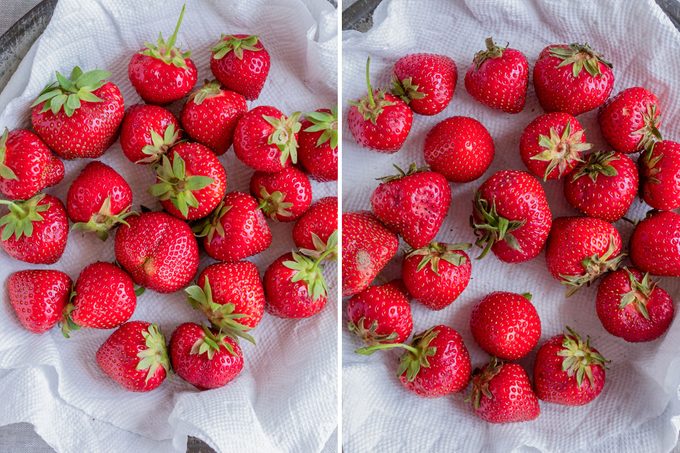
About this method: Crisper drawers in refrigerators are designed to be storage spots for fruits and vegetables. The drawers have vents to create high or low humidity environments that help produce last as long as possible.
How to do it: Place whole strawberries on a tray lined with clean paper towels or reusable refrigerator liners (to help absorb moisture on the strawberry surfaces or leaking juices.) Once your tray of berries is in the drawer, open the vents to let moisture escape and keep humidity low. This method is best for whole strawberries.
The verdict: It works
After seven days, the strawberries for the most part looked good. Although the leaves were limp, and we did find one berry that was beginning to grow mold, the majority of the strawberries were still firm and ready to eat.
The crisper drawer does what it’s supposed to do: it prevents moisture from building up on the strawberries, so they stay firm. Spacing the berries apart in a single layer on absorbent paper towels was also key to keeping the berries dry. If you weren’t already using your crisper drawer and paper towels for fruit, it’s about time you did!
Method 4: FreshPaper
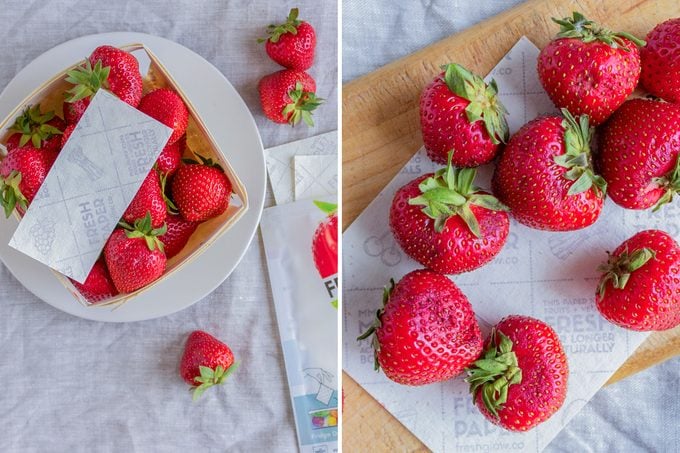
About this method: FreshPaper is a product designed to keep produce fresher longer. The compostable paper sheets are infused with spices that naturally inhibit the bacteria that cause fruits and veggies to spoil. (And the sheets smell amazing!)
How to do it: The directions for FreshPaper say to drop a sheet in with your produce wherever you’re storing it. We tucked a sheet in the original container holding our strawberries. It can be used with whole or cut strawberries, but because cut berries are more perishable, you should add an extra sheet of FreshPaper to the container.
The verdict: Pretty good
The results with FreshPaper were similar to those of the strawberries in the crisper drawer; the majority of the berries were still firm and tasty. FreshPaper seems to keep its promise of inhibiting bacteria since there was no mold on the strawberries.
Because the berries were piled in a carton, there was less airflow to the ones near the bottom. Those berries had begun to develop soft spots. If berries were laid in a single layer with a sheet of FreshPaper, we think they’d do well in the fridge for the full seven days.
Method 5: Freezer
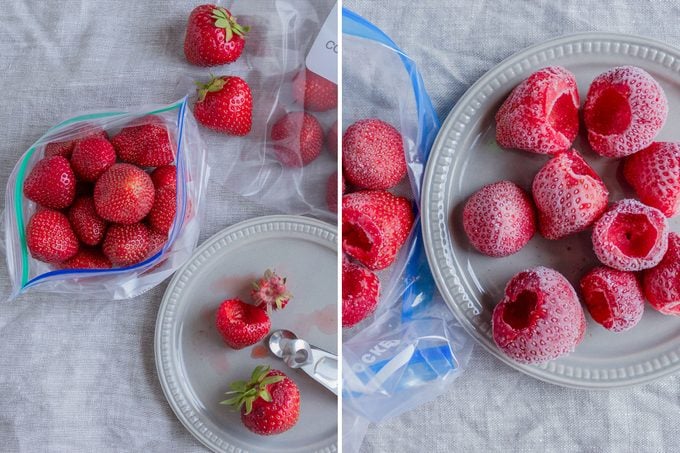
About this method: Fresh berries are stored in freezer bags in the freezer, where they last for months instead of days.
How to do it: Rinse and dry whole strawberries, then remove the stem and leaves with a knife or hulling tool. (This makes the berries easier to use once they’re thawed. The right berry tools will make the process go much more smoothly.) Place the strawberries inside resealable freezer bags, and press out all the air. Freeze the strawberries in a flat, single layer. Once frozen, you can move the bag where you need to in your freezer. This method can be used for whole or cut strawberries.
The verdict: Great for long-term storage
Strawberries freeze beautifully, and this method gives you the chance to hang on to their summer flavor longer than when they’re stored in the fridge. When sealed well, strawberries last for several months in the freezer. Use thick, freezer-safe bags so that your strawberries won’t absorb odors. Squeeze all the air out to prevent freezer burn from forming.
The downside to freezing berries is that they’ll be soft and juicy when you thaw them—not the best for snacking. It’s better to use frozen berries in things like smoothies, milkshakes, muffins and strawberry syrup.
Method 6: Mason jar
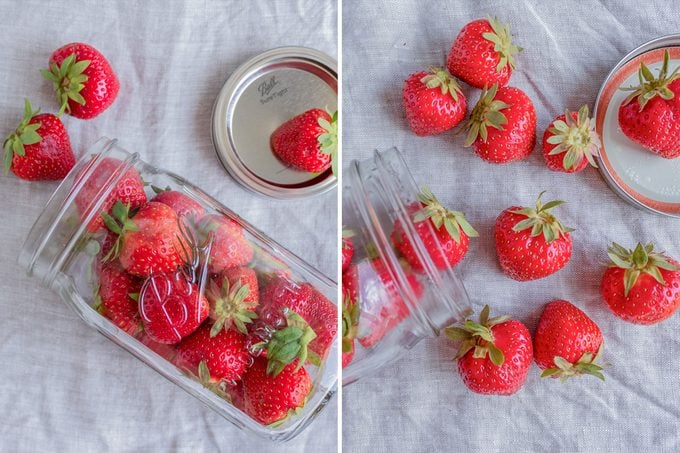
About this method: Fresh, whole strawberries are sealed inside glass Mason jars with metal lids and bands and then refrigerated.
How to do it: Check through your strawberries to remove any that have mushy spots or mold. Place your unwashed strawberries in a glass mason jar, and stack them loosely so that they aren’t squishing each other. Tightly fasten the metal lid and band on the jar, then put it in the fridge. This method works best with whole strawberries.
The verdict: We love it!
This is our favorite of the six methods. If you don’t see any difference between the before and after photos of this method, it’s not a trick. After seven days, the strawberries looked as fresh as they did on day one: plump and firm with fresh-looking leaves. It was so satisfying to find our strawberries looking and tasting this perfect after a week in the fridge. Because no air gets into the sealed mason jars, the fruit resists decaying. There’s just enough natural moisture trapped inside to keep the berries firm and the leaves vibrant.
When we opened the jar, it made the same pssshh sound that you hear when opening a soda. That’s the escaping ethylene gas produced by the strawberries. It’s important that the strawberries go into jars unwashed and that any iffy berries are removed so they don’t affect the rest.
Tips for Storing Strawberries
No matter which storage method you try, there are a few rules to know about storing fresh strawberries. Avoiding common berry mistakes will help your fruit stay fresh and better looking longer.
Sort the berries
Just as one bad apple can spoil the bunch, one moldy or deteriorating strawberry will cause the rest of the berries to spoil faster. Check boxes of strawberries carefully at the store before you buy them. When you get your strawberries home, sort through them and remove any that have mold or look mushy.
Leave the stem and leaves on
Hulling strawberries, or even just tearing off the leaves and stems, exposes the flesh of the fruit to air and bacteria, which will cause them to decay more quickly. It’s best to leave strawberries whole with leaves and stems intact until you’re ready to use them.
Wait to wash them
Strawberries absorb water quickly. Once the surfaces are saturated, they’ll quickly turn to mush or grow moldy. Wait to clean strawberries until just before you’re ready to use them. Rinse the berries quickly in cold water, and handle them very gently. Then, spread them out on a tray lined with a clean dish towel to air dry. Turn them occasionally, so they can dry on all sides and around the leaves. Once they’re completely dry to the touch, use them right away.
Store in the refrigerator
Unless you’re planning to eat or use your fresh strawberries within a day of bringing them home, the refrigerator is the best place to store them. (And you can choose which method to try!) The cold temperature will slow down the spoiling process, so your berries will last longer.
